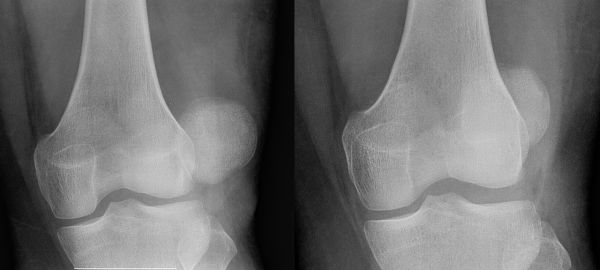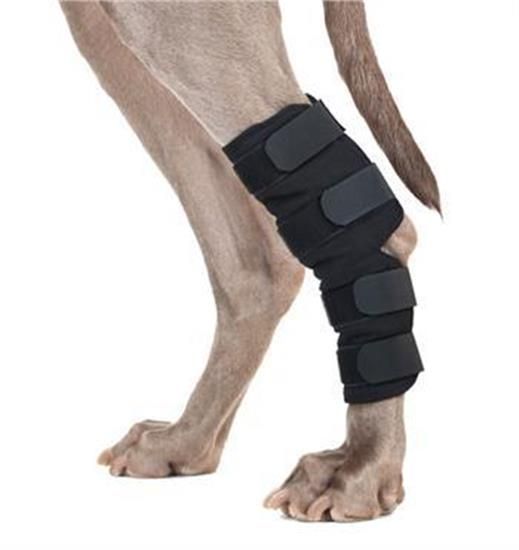It’s common knowledge that as we get older, our bodies fall apart. Unfortunately, this applies to our pet companions as well. If you’re a small breed dog owner, you might start noticing your furry baby having some complications out of their back legs. This could be something they’ve had since birth, or it could be something they’re developing as they get older. There are ways you can help them. Before jumping to surgery, consider a knee brace for dogs with a luxated patella.
Knee Brace For Dogs With A Luxated Patella
Luxated patella is the medical term meaning dislocated kneecap. You may also hear it referred to as a trick knee. This condition causes the patella (knee) to slip out of alignment. It affects 98% of small dog breeds, although there are some large breeds that are susceptible as well. This condition is often seen with other skeletal afflictions, like hip dysplasia. It’s a congenital defect that many small dogs are born with. However, it is also genetic so those that are born without symptoms will most likely develop them later on in life.

It is recommended not to breed dogs that have a luxating patella since the prevalence of it being passed to future generations is so high. Other than noticing that your dog’s knee keeps moving out of alignment, there are some other symptoms to watch out for.
- Popping in the knee
- Dog won’t apply weight to the bad leg
- Shows signs of pain
- Walks abnormally
- Limps
- Has a hitch in their step
- Sits with knee placed outward
Which Grade is The Luxated Patella?
If you suspect that your pet has a luxated patella, take them to a veterinarian for confirmation. In most cases, your pet will be fine with a knee brace, a change in diet, extra vitamin supplements, anti-inflammatory medications, and limited physical activity. Your vet will do an examination and give you a grade of one to four to define your dog’s condition. For grades I and II, surgery isn’t necessary. A knee brace would suffice.
- Grade I – This is the first stage and your dog will not have any pain. The knee will easily massage back into place. A three-piece neoprene brace ordered offline or prescribed by the doctor will help keep the patella aligned.
- Grade II – This is when the condition begins to advance. You can still massage the knee back into place and there isn’t any pain, but the frequency of the dislocation increases. This can lead to arthritis and pain in the knee. Rarely needs surgery at this point but can progress there in the future.
- Grade III – At this level, your pet is already experiencing arthritic pain. The knee stays out of place more often than not. Many vets will begin to recommend surgery.
- Grade IV – This is the final stage. By this time, there is no groove left in the leg to hold the knee in place so it stays dislocated. At this rate, the canine knee requires surgery. One physical sign that your dog has reached this point is that they now look bowlegged.
Knee Braces For Dogs

If your pet is showing signs of a luxating patella, your veterinarian might recommend a brace, which would be made of a soft mesh material. The fabric needs to be thick and stretchy to allow for a good range of mobility, but you don’t want it to chafe or irritate your pet’s skin. A suitable brace usually extends from the hip, covering the stifle joint, which is the back of the leg where the dog knee joint is. It will have a hinge around the knee so the dog can still move around.
There are videos on YouTube about how to make your own but most braces are within a reasonable price range, so it’s a better idea to purchase one instead. But if you’re the creative sort, look on Google and see what you can find. In addition to soft material and a hinge, you’ll also need some type of strong support that presses against the front of the rear leg, as well as on the underside, nestled against the groin.
Knee braces are often used for other conditions than just trick knees and luxated patellas. Examples include cranial cruciate ligament rupture, which is when the ligament that connects the thigh bone and lower leg bone tears. This is the most common reason for a dog to become lameness, or have difficulties using their back legs. Braces can also be used for ACL injuries, which are common in large breeds. This condition makes it difficult for your dog to sit or walk properly and affects the femur and tibia. Braces also work for CCL tears, hock or wrist sprains, and hip dysplasia.
If It Looks Like Surgery Is Your Only Option
It’s difficult to watch your once playful puppy no longer be able to run or jump because of their condition. If using a knee brace isn’t helping, surgery may be the only option that will improve the quality of life for your pet. There are some important factors to know before you head this route.
First off, surgery can be expensive. Not just the actual procedure, but the pre-ops and post operation care. You can expect to incur costs of at least $1,980 for a unilateral medial patella luxation. Or $2,980 for a bilateral medial patella luxation. A unilateral surgery means the repair will only be on one side, whereas bilateral means both. Once the surgery is complete, you’ll still have to cover costs of post op like follow up visits, hydrotherapy, physiotherapy, and medications.
Factors that affect the price are your location, the individual vet’s fees, size of your pet, and the grade of luxating patella that will need to be repaired. A good note though, that knee brace you purchased before surgery was considered can still be used now during the recuperation process.
There are different types of surgery that are used for the correction of patella luxation. These are: quadriceps femoris realignment surgery, which is when the patella bone is repositioned in the groove of the knee and is also referred to as tibial tuberosity transposition; deepening the Trochlea groove, which is when the orthopedic surgeon deepens the groove where the kneecap is supposed to sit; and femoral osteotomy surgery, which is when the femur bone is cut above the knee joint and re-stabilized with pins and screws.
The recovery time is around six to eight weeks and there is a 93% success rate for grade 4 surgery. However, like any type of surgery, there are risks. The surgical implant could shift into the wrong position, requiring further operations. There might be complications during anesthesia, which is common for humans and canines. The surgical area could become infected. Or in the worst-case scenario, your pet won’t be able to fully recover.

Kassidy Shepperd is the editor in chief for Canine-Prime.com. She is is a dog lover/trainer, a freelance writer and a volunteer at many pet rescue and shelter centers. Kassidy is based in Colorado and regularly writes for dog related magazines and blogs.


